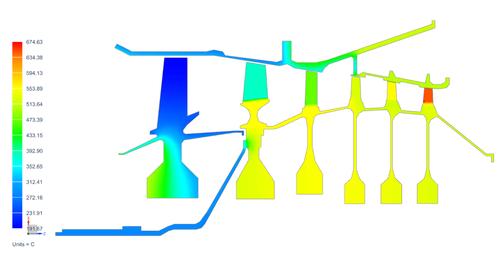Seamless 3D Simulation Blending Big Data into CAD
March 31, 2015

For decades, simulation had a specific and narrow role in product design. The process was used to crunch numbers on materials and stress forces for automobiles and spaceships. Simulation work was done by analysts who would wait days, weeks, even months for deep calculations. That was before your iPhone was more powerful than the NASA computers that took us to the moon. Using simulation in design now is easier. Processing speeds are faster and the tools are embedded in the CAD program.
Faster processing speeds have changed the world of 3D simulation. Simulation number crunching has become part of the phenomenon called big data, where vast amounts of data are no longer unwieldy. "Our customers are telling us that it used to take eight hours for simulation, and now it takes only one hour," Ravi Shankar, director of simulation product marketing at Siemens PLMtold Design News. "Something that used to take all night now comes back quickly."

One of the critical factors of rapid simulation is the ability to continue working on the design during the simulation process. If you don't have to shift the design off to analysts, and if you can conduct simulation on the same computer running your CAD, you don't have to interrupt the design process. "Design engineers can now communicate design changes more effectively. That's critical in how design processes function. You don't want the disputation you used to get when you had to throw the design over the wall for simulation," said Shankar. "Now it's rapid. You do the simulation. You figure out what needs to change, and you can have two or three simulation iterations each day. That speeds the design process."
Simulation integrated with CAD
One of the big changes for design engineers is the combo of CAD and simulation. This is not simply, here's the simulation tool and here's the CAD tool. Instead the two are integrated in a workflow tool so users can shift from one to another while working on a product. "Typically the investments we make in our software tools offer capabilities that didn't exist before. In the case of simulation and CAD, we make the workflow more efficient," said Shankar. "We invested in going easily from a CAD model to a mesh model so users can get an estimate of the performance of a vehicle or other product seamlessly."
MORE FROM DESIGN NEWS: Software Platform Simulates Operation of Hybrids, EVs
This is more than just eliminating the pause in the design process during simulation. This is blended CAD and simulation. "The world of simulation has changed since the 80s. Users design their work with 3D CAD and simulation. The simulation is integrated. It's embedded in the 3D CAD," Delphine Genouvrier, senior product portfolio manager at SolidWorkstold us. "People can use the simulation while they design their products. We can run simulation analysis on the flow in plastic injection while working on the CAD. You don't have to learn a new product or go from one application to another."
The mix of simulation and CAD allows the user to make changes to the design while the simulation is progressing. "You do a search analysis, and it's nonlinear when your product is made of rubber. What we offer is a capability to view the results as you run the analysis," said Genouvrier. "The integration makes it easy to see the progress and make changes without waiting for the simulation to be complete. That allows you to run more analysis in the process."
MORE FROM DESIGN NEWS: Using CFD to Design an Environmentally Friendly Car
The goal is to give the design users an easy way to shift from CAD to simulation and back. So it's not just the same tool for simulation and CAD, it's actually a workflow tool. "At Siemens we're investing in integration of technologies and spending effort to make sure our customers experience a smooth workflow," said Shankar. "We're able to do this with a common mesh of technology.
Reliability is also a factor that can be simulated during the actual product design process. "SolidWorks is strong in tools to design machinery and simulate machinery," said Genouvrier. "Machines experience fatigue after hundreds of times; we do fatigue simulation with vibration and see the reliability of the product. So it's important in use where there are hundreds of times of use."
Rob Spiegel has covered automation and control for 15 years, 12 of them for Design News. Other topics he has covered include supply chain technology, alternative energy, and cyber security. For 10 years he was owner and publisher of the food magazine, Chile Pepper.
About the Author(s)
You May Also Like





